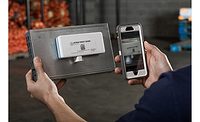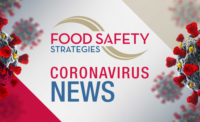Best practices in produce postharvest handling and sanitation

Sanitation with produce doesn’t just stop once the plants have been harvested. There is a procedure that ideally must be followed, before the plants arrive in the hands of the consumer.
According to Iowa State University Extension, “post-harvest management practices that reduce product loss to spoilage or shrinkage will reduce microbial risks.” These include cleaning the product, sorting, packaging, quick cooling, good refrigerated storage, and good transportation and distribution.
GMPs (Good Manufacturing Practices) must also be observed. These include packing facility sanitation (building, equipment, and storage), water quality, and worker hygiene.
“Good Agricultural Practices (GAPs) can improve produce quality and safety, protect business, and improve consumer safety. GAPs contain numerous factors including documentation, process validation, roles & responsibilities, recordkeeping, equipment/materials/worker maintenance. To create the system, one must assess and understand the risks of their operations. GAPs are not uniform; different challenges exist depending on specific operations, product and environment,” says Maria McIntyre, produce safety advocate, bioMerieux, Hazelwood, MO.
“Similar to GAPs, GMPs are a system to ensure produce are consistently produced/processed and controlled per quality standards to minimize risks to the final product. The system contains numerous factors including documentation, product/material testing, production/process controls, and training and internal audits of the system and routine reviews of GMPs,” explains McIntyre.
“To create the system, one must assess and understand the risks. GMPs are not uniform; different challenges exist depending on the type of structure where fruits and vegetables are packed or processed, and how produce products are handled. Any surface that comes in contact with food, either directly or indirectly, is a food contact surface. This would include preparation tables, spinners, food bags, and cartons for transporting produce,” she adds.
“This would also include containers for harvesting and transportation, tables in packing areas, bags and other packaging materials, conveyors, processing equipment, employee aprons, outerwear, and gloves. Hands also may come into contact with the food.”
She says examples include:
- Zone 1: Direct food contact surfaces such as conveyors, belts, brushes, rollers, sorting tables, racks, utensils, harvest bins, and hands. Zone 1 holds the largest concern as the surfaces are in direct contact with the produce. If the surface is contaminated this could result in contamination of the entire line.
- Zone 2: Non-food contact surfaces in close proximity to produce: internal/external parts of washing or processing equipment.
- Zone 3: Areas inside immediate packing including trash cans, cull piles, floors, drains, forklifts, phones, and storage areas above packing areas.
- Zone 4: Areas outside of or adjacent to the packing area; for example: loading docks, warehouses, manure/compost piles, and livestock operations.
“Water is critical to all elements of produce, it’s important to know and continually reassess the risks including the water source within the packaging/processing facility,” McIntyre adds.
She also notes that some areas of the produce industry are exempt from GMPs; they focus on sanitation practices is good for reducing food safety risks in fresh produce operations. At times, exempt groups find benefit in GMPs and implement the philosophy in the interest of food safety.
Packing House sanitation should include proper sorting and culling of product, maintaining detectable free chlorine in wash waters, enforcing good worker hygiene, and cleaning and sanitizing equipment. Businesses will also want to exclude all animals from the Packing House, especially insects, birds and rodents.
Ideally, a packing facility should be arranged so that “each product moves to a cleaner area during each step of processing,” says Iowa State University. Good sanitation and housekeeping should be practiced in the area (SOPs, aka Standard Operating Procedures). Cleaning supplies should be stored in a separate area, and restrooms should not open directly into processing and packaging areas.
The facility should also have adequate lighting and be shielded to protect the product, in case breakage occurs. Processing equipment food contact surfaces should be cleaned and sanitized, and this should be done as frequently as necessary. Only food grade machinery lubricants should be used, and exposed overhead piping and ducts should be minimized and kept clean, says ISU.
Other important things to note:
- Work tables and/or product preparation surfaces, or anything food comes into contact with, should be smooth, to allow for easy cleaning. Rough surfaces harbor dirt and microorganisms.
- It’s important to clean and sanitize as needed—wash, rinse, and sanitize with approved food contact agents.
- Store packing containers away from contamination sources, and make sure to close the doors at night.
Maintaining postharvest quality
The Postharvest Center of the University of California has a website which includes crop-specific details related to ideal postharvest storage conditions.
Users can choose their crop(s), and then look at recommendations for maintaining postharvest quality, as well as information on the maturity and quality for each crop. Other information includes temperature and controlled atmosphere, and information on any disorders that the crop may experience.
Training for on-farm fruit and vegetable operations in the Produce Safety Rule is proceeding, says Merieux NutriSciences (1/24/19, “Sanitation and Post-Harvest Handling of Produce”). Although the Produce Safety Rule training follows a format that was developed and implemented by the Produce Safety Alliance, Subpart K of the Produce Safety Rules specifically addresses the sanitation of surfaces that have contact with products/crops.
“Specifically addressed is the need to adequately clean and sanitize contact surfaces such that product is protected against contamination with known or reasonably foreseeable hazards. Products that are processed or pass through an on-farm or off-farm packing shed are subject to cross-contamination,” says Merieux NutriSciences.
“Traditionally, packing sheds were seen as a part of farming operations. For cross-contamination prevention to occur these operations need to be considered as processing operations where hazards and risks are analyzed accordingly as part of a food safety plan hazard analysis and strategies implemented that are designed to prevent cross-contamination. Part of the food safety system is developing effective sanitation programs that provide for sanitary equipment surfaces and shed operations,” it says.
“Worker education and training will reduce the risk of postharvest contamination. Training for on-farm fruit and vegetable operations is outline in the Produce Safety Rule. With implementation with the Produce Safety Rule, state departments of agriculture and FDA offer on the farm educational inspections. This is a precursor to a regulatory inspection,” states McIntyre.
“Within the rule, there’s an emphasis on worker hygiene, soil, wildlife, animal intrusion, and irrigation water testing.”
“Training is challenging in produce for many factors including the seasonality of the industry and the workers. Worker education and training will reduce the risk of postharvest contamination. Training should include any glove and preventative equipment policies and accurate use, proper handwashing and bathroom use, cleaning and sanitizing tasks, and eating and drinking policies,” explains McIntyre.
“Further training on food safety and the entire quality system of the organization including SOP’s is valuable to harvest operations. Training is needed on all procedures to be conducted. It’s beneficial to have the worker trained on the process, they demonstrate the process and the actions are audited,” she says.
A training program is one portion of the GMPs internal audits of the system and routine reviews of GMPs, McIntyre explains.
“Not following procedures appropriately may adversely affect the company and human health. More and more commonly, we are seeing food safety programs expand and become part of the culture of the organization. This includes sharing a vaster perspective with employees.”
Cornell University’s “On-Farm Decision Tree Project: Sanitation and Postharvest Handling—v5,” states that workers are responsible for following the SOPs to properly clean and sanitize food contact surfaces. (7/22/2014, Sample SOP: Cleaning and Sanitizing Surfaces, Tools, and Equipment).
“Farm owners and food safety managers are responsible for training the workers on proper technique, providing necessary resources such as tools, detergents and sanitizers, and making sure the cleaning and sanitizing steps are followed correctly,” it says.
Proper procedure includes the following, says Cornell:
- The surface should be brushed or rinsed to remove visible dirt and debris.
- Prepare the detergent.
- Apply the prepared detergent solution and scrub the surfaces moving in the direction top to bottom for large pieces of equipment. Detergent should be mixed according to the product instructions.
- Rinse the surface with clean water until all soap suds are rinsed away moving in the direction top to bottom for large pieces of equipment.
- Prepare the sanitizer.
- Apply the prepared sanitizer solution. Allow it to sit for [Enter number of minutes according to product instructions] minutes.
- Rinse with clean water.
- Let the surface air dry.
“Water Quality 'infected' water is taken up by the root structure and then into the vascular system of plants. Once it is inside the plant will carry the organism with it throughout its life. Water is critical to all elements of produce; it’s important to know and continually be reassessing the risks including the water sources on the field, runoff from adjacent systems, municipal or well water, applied water, and water within the packaging/processing facility,” says McIntyre.
Looking for a reprint of this article?
From high-res PDFs to custom plaques, order your copy today!






